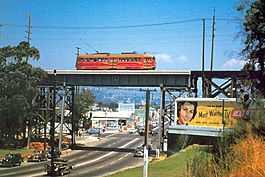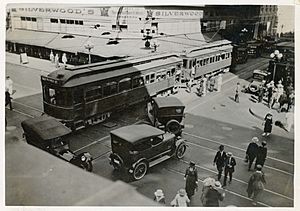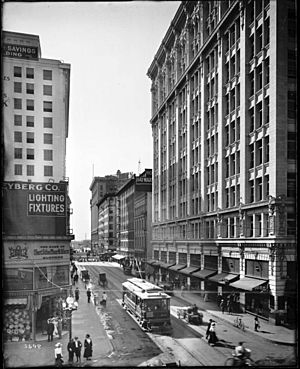Glendale–Burbank Line facts for kids
Quick facts for kids Glendale–Burbank |
|
|---|---|
 |
|

A Downtown Los Angeles-bound Red Car near the intersection of Fletcher Drive and Riverside Drive.
|
|
| Overview | |
| Locale | Southern California |
| Termini | Subway Terminal Burbank |
| Stations | 21 |
| Service | |
| Type | Interurban |
| System | Pacific Electric |
| Operator(s) | Los Angeles Pacific Railroad (1904–1908)
Pacific Electric (1908–1953) Metropolitan Coach Lines (1953–1955) |
| Rolling stock | PE 5000 Class PCC cars (last used) |
| History | |
| Opened | April 6, 1904 |
| Closed | June 19, 1955 |
| Technical | |
| Track gauge | 1,435 mm (4 ft 8 1⁄2 in) standard gauge |
| Electrification | 600 V DC Overhead lines |
The Glendale–Burbank was a special railway line in Southern California. It ran from 1902 to 1955. This line connected Downtown Los Angeles to Burbank. It also passed through Glendale. Shorter train trips also ran within Downtown and North Glendale. One popular short trip was called the Edendale Local.
Contents
The Train Route: Where Did It Go?
The Glendale–Burbank train journey began at the Subway Terminal Building. This was a big station in Los Angeles. After leaving the Hollywood Subway, the train tracks went through the Toluca yard. They then crossed under the Beverly Boulevard Viaduct.
The tracks then ran down the middle of Glendale Boulevard. They went north, crossing Temple Street. In the 1950s, they even went under the Hollywood Freeway. The tracks continued along Glendale Boulevard. They passed Park Junction, which was near Sunset Boulevard. Here, trains could connect to the Hollywood Line.
The Glendale Line went under the Sunset Boulevard Bridge. It then entered a special three-track area. This allowed Glendale and Edendale trains to pass each other easily. This three-track section continued north along Glendale Boulevard. It passed streets like Montana and Alvarado.
The tracks then became two again and ran on the street. They went to Allesandro Street. Here, the tracks left Glendale Boulevard. They entered a private path through the Ivanhoe Hills. This path went past Lakeview Avenue and India Street. Eventually, it ran next to Riverside Drive.
A tall wooden bridge carried the tracks over Fletcher Drive. This bridge was about 40 feet (12 meters) high. The line kept going northwest, still along the hills. It reached Monte Santo, where Glendale Boulevard meets Riverside Drive.
From Monte Santo, three bridges carried the tracks over Riverside Drive and the Los Angeles River. The line then went through the Atwater area. It followed a private path in the middle of Glendale Boulevard. When it reached the Glendale city limit, it crossed the Southern Pacific's Coast Line tracks.
The two tracks then crossed San Fernando Road. The private path ended here. The line continued north on Brand Boulevard. It crossed major streets like Los Feliz Boulevard and Colorado Boulevard. The main line went north to Verdugo Wash. Here, the line became a single track.
At Arden Junction, near Glenoaks Boulevard, the line split. The old main line continued north on Brand Boulevard. It ended in North Glendale at Mountain Avenue. The Burbank Line turned west. It was a single track on a private path in the middle of Glenoaks Boulevard. It continued west past several avenues. It ended in Burbank at Cypress Avenue. From 1925 to 1940, the Burbank Line went even further west to Ben Mar Hills.
Key Stops Along the Way
The Glendale–Burbank line had many important stops. Some of the main ones included:
- Subway Terminal Building: This was the starting point in Los Angeles. It opened in 1925.
- 6th & Main Street Terminal: An earlier starting point in Los Angeles, used from 1904 to 1925.
- Atwater, Tropico, Glendale, and North Glendale: These were key stops within Glendale.
- Burbank: The main end point in Burbank. It opened in 1911.
- Benmar Hills: An extended stop in Burbank, used from 1925 to 1940.
These stations helped people travel easily between cities.
History of the Glendale–Burbank Line
The Los Angeles Pacific Railroad first built this railway line. Construction on the Brand Boulevard part started in 1903. This was done by the Glendale and Montrose Railway. But they sold the rights to the line soon after. The line officially opened on April 6, 1904. It ended at Mountain Street.
The Los Angeles Interurban company later took over the line. Then, Pacific Electric took control in July 1908. At first, trains started at Main Street. Service to Burbank began on September 6, 1911. A branch line to East Glendale opened on May 1, 1914.
Pacific Electric even tried a joint service with the Glendale and Montrose Railway. This was between 1916 and 1917. Trains ran from the Pacific Electric Building to Glendale Avenue. They then turned north on the other railway's tracks. They went all the way to La Crescenta. But this route did not have many riders. So, it was stopped in less than a year.
The line was extended to Eton Drive on July 20, 1925. Local land developers helped pay for this extension. Starting on December 1, 1925, trains began using the Hollywood Subway. This subway, also called the "Belmont Tunnel," helped trains avoid busy streets. It connected the Subway Terminal Building to Glendale Boulevard.
In 1936, many train trips were replaced by buses. But people in Burbank and Glendale really wanted the trains back. So, the California State Railroad Commission asked the railway to bring back more service. A full train schedule was restored in 1940. At the same time, the Eton Drive extension was stopped.
The last train on the Broadway section ran on Christmas Eve 1946. On October 1, 1953, a new company took over. This was Metropolitan Coach Lines. They started reducing train service. Rail service to North Glendale stopped on June 18, 1955. Burbank service also ended on the same day. The train routes were then changed to bus routes.
All the train tracks along the route were removed by 1981.
The Trains Used
After 1936, Pacific Electric bought special trains. These were called double-ended PCC streetcars. They were unique because they could go in either direction. These trains could be linked together to form trains up to three cars long. These special cars were retired in 1955 when the train service ended.
The Edendale Local Train
There were also shorter train services on this line. One was called the Edendale Local. It started at Whitmore Avenue in Edendale. It ran south, avoiding the Hollywood Subway. It used surface tracks to reach the Southern Pacific Railroad's Arcade Depot. This depot later became Central Station.
In 1936, these local trips were extended north to Monte Sano. When Union Station opened, tracks to the old Southern Pacific depot were removed. So, the Edendale Local trains started using the Hollywood Subway in September 1940. By November of that year, the main Glendale–Burbank trains took over most local duties. Edendale Local runs were only during busy rush hours.
The Edendale Local line became very busy again during World War II. But after the war, dedicated service slowly stopped. Metropolitan Coach Lines finally ended the last Edendale Local runs in June 1955.




